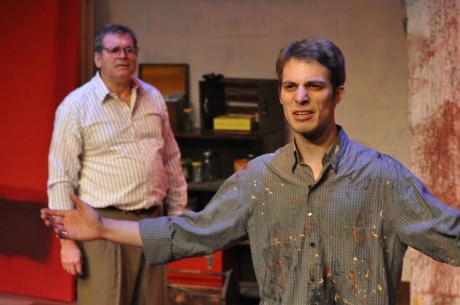“Artists should starve,” Mark Rothko insists in John Logan’s 2010 Tony Award-winning play Red. “Except me,” he concludes wryly. That one line encapsulates the play’s exploration of contrasts – contrast of colors in a painting, contrast between art movements and generations, and most importantly, the contrast between what Rothko says and what he does. These themes are explored quite movingly in the Elden Street Players’ high-caliber production.

The play centers on American painter Mark Rothko, during the height of his fame in 1958. He has been commissioned to paint a series of murals for the swanky Four Seasons Restaurant in Manhattan. The real Rothko was cryptic in his intentions behind taking this “commercial” venture, but Red explores that subtext, though conversations with Ken, the assistant he has hired to help him with the job.
One could argue that the third character in this two-character show is art itself, perhaps more specifically, Rothko’s art. It is fitting then that all the production’s design elements are integral to the world of his painting. Ian Mark Brown’s set is an apt recreation of Rothko’s Bowery studio, a re-purposed gymnasium. Tall white walls allow one to imagine the enormity of the Four Seasons murals, and paint splatter covers everything from the sink to a nice green upholstered chair, but noticeably not the floor—a representation of Rothko’s brand of ordered chaos. Mary Speed contributed the original Rothko-inspired paintings that hang on Brown’s set.
Light was very important to Rothko’s work, and Anne Marie Castrigno’s lighting design champions his vision. For most of the play, the studio is shrouded in a dimness that highlights the paintings’ bright brilliance. There is a very effective scene where the lights get brought up to full, which casts the room in a harsh yellow-white tint, a tint that matches Ken’s assertion that “this light hurts.”
Judy Whelihan’s variety of color-stained smocks and Stan Harris’ selection of the classical music records Rothko paints to round out the superb design. One standout scene uses the musical scoring to great effect. As Mozart’s Clarinet Concerto in A swells in the background, Michael Kharfen (Rothko) and Brandon Herlig (Ken) paint a base coat for the next mural. Impressive enough as it is to watch two actors paint an entire canvas on stage, what makes this scene great is Director Gloria DuGan’s staging. Kharfen paints as if he is conducting the opera; his brushstrokes are musicalized movements. Herlig’s are steady, less showy. There’s both humor and real competition as we see them crisscross and get in each other’s way.
While the play’s talky nature doesn’t immediately lend itself to dynamic staging, DuGan pulls it off just fine. Most of Kharfen and Herlig’s interactions are a power play, and DuGan sends them spinning around the room, in search of the upper hand. She also knows when it is more effective to ground them, particularly Kharfen, whose Rothko gesticulates wildly, his arms an extension of his volatile emotions.
Kharfen and Herlig are equally terrific as master and servant, teacher and pupil. Kharfen bursts onto the scene as an insufferable genius, but this is no caricature. The way he spits his pretentious diatribes tells you more than the rants themselves do. He hangs on to his own every word with absolute seriousness. Rothko does not love to hear himself talk; he loves what he talks about.
For as much as he sneers about Jackson Pollack’s character failings, Kharfen sneers with a passion for his subject. On a dime, Kharfen can turn that sneering into childlike awe, while maintaining the same intense gaze. And even more suddenly, he collapses into momentary heartbreak. Kharfen’s strength is in making this sequence of transformation seem like one continuous thought. He feels all these intense emotions all the time, and they threaten to burst out constantly.
While Kharfen is often transforming within scenes, Herlig gradually transforms over the course of the play. In the beginning he’s reservedly amiable, with a tightly controlled expression and posture. When Herlig says something with confidence, he takes a casual pose, hands in pockets, but immediately throws his arms straight by his side when questioned, stiffening back up.
When he first holds his own in an argument with Kharfen, Herlig refuses to play it as a fight, as I’ve seen in other versions. His Ken is genuinely enthusiastic about his views on art, and is not trying to best Rothko. As he endures Kharfen’s abuse, Herlig picks his battles, pitching his sarcastic lines with a dismissive whine that goes unnoticed, much to his building resentment. By the end, Herlig is not afraid to let anger and gloom flash across his face, confident that they won’t swallow him the way Kharfen’s outbursts and breakdowns threaten to swallow Rothko.
Mark Rothko believed paintings pulsate with life. Elden Street Players’ production of Red certainly does. It’s the life of an artist, a celebrity, a student, a dinosaur, a child, a hero, a rebel, and a hypocrite – a human being. “Let it pulsate.”

Running time: 90 minutes, without an intermission.
Red plays through June 29, 2013 at Elden Street Players’ Industrial Strength Theatre – 269 Sunset Park Drive, in Herndon, Virginia. For tickets, call the box office at (703) 481-5930, or purchase them online.





Hi,
We really enjoyed Red.
Could you please tell me the title of the music that played between the first two scenes?
Thank you.